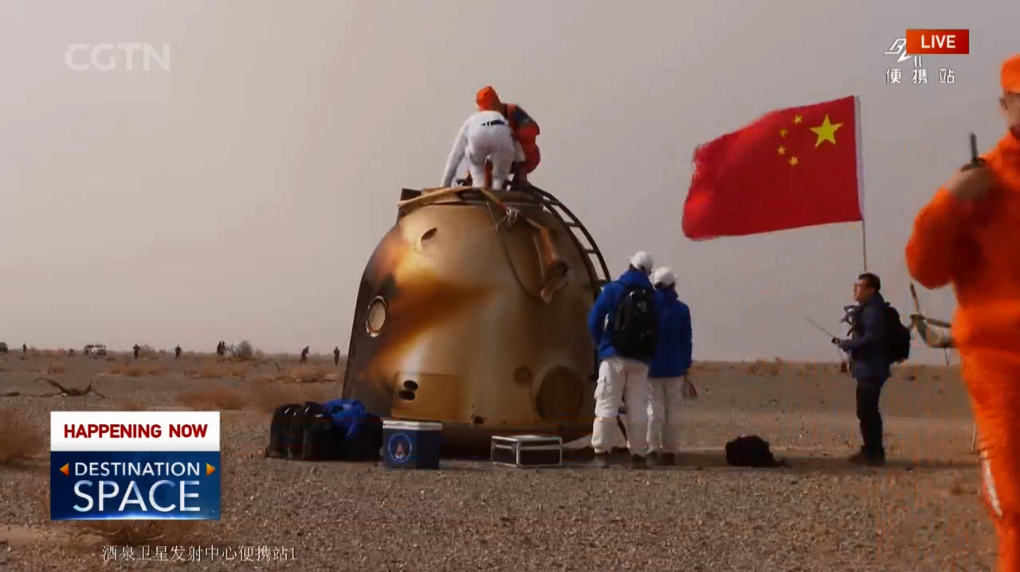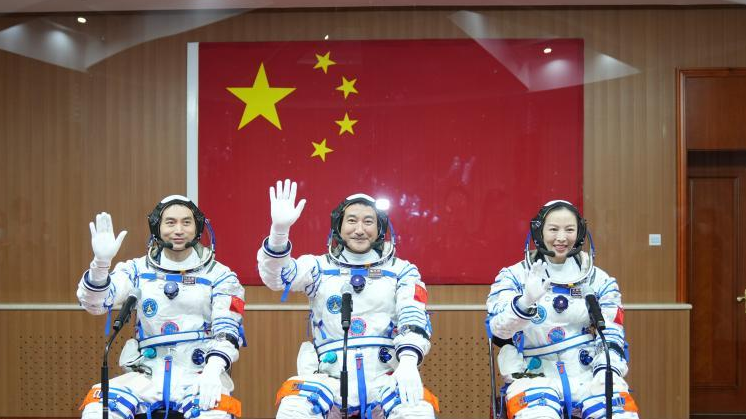
Screen image taken at Beijing Aerospace Control Center shows the main parachute of the return capsule of the Shenzhou-13 manned spaceship successfully deployed, and its descent speed slowing down, April 16, 2022. /Screenshot via CGTN
Screen image taken at Beijing Aerospace Control Center shows the main parachute of the return capsule of the Shenzhou-13 manned spaceship successfully deployed, and its descent speed slowing down, April 16, 2022. /Screenshot via CGTN
Editor's note: Yang Yuguang is vice chair of the Space Transportation Committee of the International Astronautical Federation. The article reflects the author's opinions and not necessarily the views of CGTN.
The three Shenzhou-13 astronauts have completed their six-month space mission and returned to Earth safely on April 16.
Crew transportation, rendezvous/docking and extravehicular activity are called the three fundamental technologies of human space flight. For any space capable nation that wants to have a space station, or to have a human mission to the Moon, it must master these three technologies. During the intensive space race between the former Soviet Union and U.S. in the mid of last century, they mastered these technologies via Vostok, Voskhod, Soyuz space programs and the Mercury, Gemini, Apollo programs respectively.
For China, we mastered crew transportation technology through Shenzhou-5 and Shenzhou-6 missions. We tested extravehicular activity via Shenzhou-7 mission. By conducting Tiangong-1/Shenzhou-8, 9, 10 missions, we mastered rendezvous and docking technologies. Therefore, Shenzhou-10 mission becomes China's first operational mission, rather than an experimental mission.
Coincidentally, Wang Yaping, the second female astronaut and the first space teacher of China, is a crew member of both the Shenzhou-10 and Shenzhou-13 missions. With the safe return of Shenzhou-13 re-entry capsule, she and her crew members made history again. The Shenzhou-13 spaceship achieved both fast rendezvous/docking and fast return. This shows that China made new progress on crew transportation technology.
About six hours after being launched from Jiuquan Satellite Launch Center, Shenzhou-13 spaceship successfully rendezvoused with Tiangong space station and docked to Earth-facing docking port. This is not easy. To connect to spacecraft together, the basic requirement is that the second spacecraft must enter the same orbital plane of the first one. Considering that the Earth is rotating continuously, usually we don't have other choices but to launch the second spacecraft while the launch site is rotated to the orbital plane of the first spacecraft.
However, this is the right moment for launch but when the second spacecraft comes into orbit, usually its position is quite different from the first one. To solve this problem, we choose a relatively lower orbit because it would rotate faster and thus chase the first one. With a two-day transfer period, like the former missions, we will have plenty of chance to handle all kinds of problems. But with the fast rendezvous and docking, it raised a much higher reliability requirement to the Shenzhou spaceship. Also the orbit maneuvers must be carefully planned and conducted.

A see-off ceremony for three Chinese astronauts of the Shenzhou-13 crewed space mission is held at the Jiuquan Satellite Launch Center, China, October 15, 2021. /Xinhua
A see-off ceremony for three Chinese astronauts of the Shenzhou-13 crewed space mission is held at the Jiuquan Satellite Launch Center, China, October 15, 2021. /Xinhua
The rendezvous and docking of Shenzhou-13 spaceship with Tiangong space station was excellent, because it shows that China has mastered fast rendezvous and docking technology very practically. This has made the crew members very comfortable because they only stayed about six hours in the narrow volume. Another issue we should consider about is the "space motion sickness," which is caused by the influence of zero-G to human cardiovascular system and neural system. Usually the sickness happens six hours after coming into orbit and the astronauts will feel better in two days. With the fast rendezvous and docking, the astronauts will keep a very good status before entering the station. This also brings another advantage, if something is wrong with the autonomous docking system, the Shenzhou-13 commander may switch to manual docking mode. Because they are still in very good status, this can ensure the success of manual operations as well.
Shenzhou-13 not only accomplished a fast rendezvous and docking, it is also the first spacecraft of China that achieved a docking on radial direction. Mastering this technology is very critical for the construction and operation of China's space station. Because Tiangong space station only has one front docking port and one rear docking port. If the two docking ports are occupied by other spacecrafts, like this time, the two docking ports were occupied by Tianzhou-2 and Tianzhou-3 cargo spacecrafts. Thus Shenzhou-13 has no other choices but to dock with the Earth-facing docking port. Approaching the station from below means that the two spacecrafts are in different orbits, comparing with docking from the front or rear direction, theoretically speaking the relative position is not a stable one, which brings more challenge to the operation.
During the construction phase, the Shenzhou spaceship must dock to the Earth-facing docking port, and keep the front docking port free for the coming Wentian and Mengtian modules. In the future operation phase, during the turn over of different expedition teams, there will be two Shenzhou spaceships connecting to the station, one on the front docking port and the other on the Earth-facing docking port. Shenzhou-13 spaceship's docking showed that China has mastered this technology.
When Shenzhou-13 spaceship undocked from Tiangong space station, it took only several hours to return to Dongfeng landing zone. This fast return technology is also a remarkable breakthrough in return technology.
Similar like rendezvous and docking, Shenzhou spaceship must conduct the de-orbiting insertion when the landing zone is rotated with the Earth to the orbital plane of Shenzhou. For each day there is only one chance for this operation. Before that, the Shenzhou spaceship must have left Tiangong spacestation to a safe distance, and the orbital module must be separated from the reentry capsule. Not like missions before, Shenzhou-13 spaceship conducted all kinds of complex operations within only several hours and successfully performed the de-orbiting burn. And then the propulsion module is separated. Like the fast rendezvous and docking, the fast return also ensures the Shenzhou-13 crew only stayed in narrow volume for a very short period, much more comfortable than former missions.
A faster return also benefits scientific research. During the Shenzhou-13 mission, the crew conducted many space medicine and space biology research. They brought some samples back to the Earth. Shortening the transfer period may keep the samples in an ideal storage condition.
With the success of Shenzhou-13 mission, China now is more practical on fast rendezvous/docking, radial direction docking and fast return, which shows the remarkable progress of China in crew transportation technologies.
(If you want to contribute and have specific expertise, please contact us at opinions@cgtn.com. Follow @thouse_opinions on Twitter to discover the latest commentaries on CGTN Opinion Section.)

